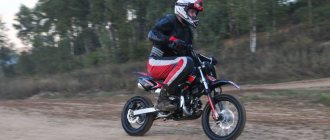How much do riders earn from stunts, what causes them to fall, and how often the falls are fatal...
Subscribe and read Express Newspaper in:
Freestyle motocross is incredible jumps on a motorcycle with acrobatic elements in the air. In Russia, at most 10 people are professionally involved in this unusual sport. On the eve of the Monster Cup in Moscow, which will host the first freestyle motocross competition in our country, we met with pro-rider, founder of the MadMen team Pavel Antonov and talked about those aspects of freestyle motocross that are usually kept silent.
— How long have you been involved in freestyle motocross and how did you get into this sport?
— Now I’m 27 years old, and I started at 12 with motocross. I practiced this sport on Sakhalin for six years, and then moved to Moscow and changed my specialization - in 2011 I started doing only stunts. It took me two years to study, and since 2013 it has become professional, with events and performances.
— Freestyle motocross is a very young sport. Tell me, how did he even appear? Some motorcycle racer just got bored and started doing tricks?
- This came from the United States, where at motocross competitions the winner usually made his last jump somehow spectacular - he could make a motorcycle or let go of his arms and legs. Then all this turned into the fact that at motocross competitions they began to hold a special contest for the most beautiful jump. As a result, the audience liked it so much that it resulted in a separate discipline in which riders only do tricks.
Photo: madfmx.ru
Requirements for motorcycles
For freestyle motocross they use classic motocross motorcycles: Honda, KTM, Suzuki and Kawasaki, but more often they choose the two-stroke Yamaha YZ250. American virtuosos “fly” on four-stroke bikes with a volume of 450 cc. cm. The weight of the cars is about 90-95 kg, with such parameters they are easier to control when performing tricks.
Beginners ride standard equipment, but as they gain skill, they independently modify the details. The athlete’s weight, riding style and preferences for the choice of elements are taken into account. On the technical side, the main thing is to reconfigure the suspension, carburetor and exhaust system.
Retuning the carburetor is necessary for a clear engine response and increased thrust at speed during short accelerations, as well as in order not to load the engine during landing. For this purpose, the exhaust system is also modified - a tuning system is installed. The suspension is specially installed for softness during landing and with reinforced springs so that the car can handle the ramp and is not afraid of long jumps and hard landings.
External changes for the convenience of performing tricks are as follows:
- placing a high handlebar on which the crossbar is removed, which makes it easier to control the motorcycle and helps to move your legs easier;
- the steering wheel is secured with a special clamp to prevent “lobbing”;
- the sidewalls are equipped with holes to hold with your hands, other places are equipped with levers and brackets, the wings are dismantled;
- the saddle is made low to make it easier to carry the legs, and a thin layer of foam is left;
- Sandpaper is added to the frame and fork to increase grip.
To make the motorcycle memorable to the judges and spectators, freestyle motocross riders add a visually striking design:
- neon lighting of bike parts;
- decorated with vinyl stickers;
- paint the swingarm, frame, front fork and wheels acid color.
Manufacturers have already launched the production of highly specialized motorcycles for freestyle motocross. The main ultra-light machine is UNIT Skycraft: carbon fiber is used to make the frame.
The emergence and development of tricks in freestyle motocross
Realizing that entertainment brings fame and money, riders began to come up with complex tricks and insert them into jumping on a motorcycle from a springboard. Gradually, tricks became mandatory for freestyle motocross and are performed from a special ramp, which helps you fly out at the right angle at a given speed and land at the right point. When performing a trick, the rider changes the position of his body in relation to the motorcycle.
2000 is the year of birth of the first complex trick, which gave rise to other, even more complicated elements. These include a somersault, or a somersault in the air (backflip) while sitting on a bike and landing on both wheels.
The set of professional tricks consists of three categories - “basic”, “intermediate” and “advanced”. A trick is an acrobatic exercise when the athlete’s body or limbs necessarily move in relation to the motorcycle, completely or partially breaking away from the machine.
Freestyle motocross as a freely developing discipline must be constantly updated with new tricks. For this reason, it is customary for freestylers to include combinations of two or three special elements into their performance programs, for which judges award increased points. New techniques appear by increasing the speed and duration of the flight, changing the angle of departure and height of the springboard, adding or changing rotation.
If earlier they did one somersault, now daredevils perform a double backflip. Some tricks are so difficult and dangerous that the rider, having performed it once, refuses to repeat it.
To practice techniques with rotation, they make a foam pit, but these tricks still require complex and exhausting training. The athlete often falls headfirst and a motorcycle is added on top. You won't be able to get out on your own. In such a situation, you have to endure and wait in the position in which you landed.
About children in freestyle motocross
— Now people also come to freestyle motocross from motocross, or can you start doing stunts straight away?
“Many people want to start freestyle right away, but it’s difficult because motocross is the foundation from which you need to start. It is impossible to immediately learn how to jump a large ramp; first you must master small earthen springboards, learn how to simply move over them, then jump a little, and so on. It's a long process.
— At what age do you usually start freestyle motocross?
— In Russia, after 20, people are just starting to come to this, although in the world they start much earlier - two years ago, a 10-year-old boy already did a somersault on a motorcycle.
— How do parents feel about the fact that their children want to do somersaults on a motorcycle at a great height?
— Well, if the parents agreed to bring their child to freestyle motocross, that’s fine. But in general, the selection goes on until the first hard fall - many leave after the first serious injury, but if a person continues to skate, then he cannot be stopped.
Common types of tricks
Freestyle motorcyclists have 20 basic tricks in their arsenal, which are considered common elements and give rise to new combinations. Such tricks include “Can-Can” without moving the legs, variations of “Clipclickers” and combinations with “Backflip”.
Backflip is the entrance exam for professional athletes.
The first trick is the “Whip”, which requires the rider to put the bike in a horizontal position and return it back to land on the wheels.
In Kan-Kan you need to cross your legs to one side of the machine.
The “Hart Attack” is performed with the body stretched out in a standing position, hands resting on the saddle and handlebars.
In “Indian Air”, as in Heart Attack, standing on hands imitates walking in the air.
To do the Cliff Hanger exercise, the athlete stands up in flight with his arms raised, hooking his toes on the handlebars.
While performing the Body Varial, the athlete manages to make a full turn over the flying motorcycle and grab the handlebars before landing.
In the “Executioner” trick, the athlete, holding the saddle, grabs his legs with his other hand and bends over.
“Clicker heel” - you need to lean your hands on the steering wheel, stretch your legs forward and tap your soles against each other.
When performing the “Rock”, the athlete, without holding on to the motorcycle, flies nearby.
The “Ruler” trick is difficult. It is a handstand on the handlebars.
When performing “Cordova”, the athlete, without letting go of the steering wheel, also clings to it with his toes and bends. Some people implement this trick when performing a backflip.
A “turn” is when the bike makes a full rotation around its axis while in flight.
A “dead body” is a trick where the rider leans forward, keeping his feet together, without letting go of the handlebars.
Tricks
There are about 20 basic tricks, but it can be said that freestyle motorcycle racing knows as many tricks as there are riders. Based on these 20, you can make a huge number of new ones. Every freestyler is proud of his signature trick and brings it to exceptional perfection.
The main reason for the popularity of freestyle motocross is, of course, its entertainment value. This sport is certainly not for the weak. A clear head, flexibility and good coordination of movements are the qualities that a rider must have in order to succeed and win the hearts of spectators.
Main directions in freestyle motocrossing for competitions
An open area or stadium is used for freestyle motocross competitions. The equipment used is motorcycles, ATVs and snowmobiles. The main thing is technically correctly performed acrobatic stunts during long jumps from special artificial springboards.
Freestyle motocross competitions consist of two programs.
- In “Big Air”, the order of the performing athletes is observed, with their demonstration of jumps and tricks. The results are summed up by the amount of points scored. For a new acrobatic combination, the rider is awarded additional points.
- Freestyle Motocross competition is a cross-country motorcycle race with the performance of stunts along the way. Victory is awarded to the one who covered the distance faster than others and at the same time performed technically purely the elements of acrobatics.
Sections of the “Big Air” program for professional competitions.
- In the direction of "Motofreestyle" in 1.5-14 minutes. you need to do a larger number of tricks compared to your opponents, often 10-15 elements.
- Competition to determine the best trick. Of the two attempts given to the rider, the one with the higher score counts. The athlete is allowed to show the same exercise or different tricks. New techniques are given the highest score.
- High jump competitions that involve clearing the bar are called “Step Up.” Here, too, two attempts are given to take the next milestone. Some masters fly up to more than 9 meters.
- Another competition for the best trick is performing the “Whip”, when the bike takes a horizontal position in the air.
- There is also an original direction called Free Riding. In this case, motorcyclists organize their own races, choosing mountainous terrain. There are no tracks laid out here, no judges are invited, and competitions for the most spectacular trick are not held.
The last of the described disciplines is fraught with serious injuries due to athletes performing extremely dangerous flights.
Judging
With the development of freestyle motocross as a separate discipline, judging rules were developed. The rating of a rider's performance consists of five criteria on a 10-point scale.
To get the highest score, freestyle motocross riders ensure that their tricks are different:
- technicality;
- complexity;
- entertainment;
- diversity;
- public reaction.
The show is evaluated by as many teams of judges as there are defined parameters to determine the winner.
Popular competitions
Freestyle motocross is held as an independent competition or as part of a complex of competitions with other extreme sports. All professional riders and crowds of spectators are eager to get to the popular freestyle moto world championship called “Night of the Jumps”.
The world show tour with the unofficial status of “Modern Gladiator Fights” (Red Bull) is also popular. Unforgettable are the traditional competitions that appeared with the separation of freestyle motocross into a separate discipline - “X - Games”. Among other competitions, the public appreciates “Masters of Mud”, “Masters of Adrenaline” and “Gravity Games”.
Those who wrote their name in the history of freestyle motocross
The pioneers who paved the way for freestyle motorcycling actually created a new type of motorsport. They finished their careers a long time ago. However, the names of these masters, forever inscribed in the history of the sport, are remembered and revered by thousands of fans and motocross enthusiasts. Beginners learn from the tricks of the pioneers and professionals of the current generation of freestyle motocross calculate flight trajectories.
Mike Jones' name is directly associated with supercross racing in the 90s. and with victories at the European Championships. However, over time, injuries forced Mike to switch to FMX and devote his career to stunts.
With 72 wins and 7 titles, Jeremy McGraff (Southern California) is known as the King of Supercross. Thanks to his jumps, freestyle motocross crystallized into a separate discipline.
Nate Adams has many championship titles from popular freestyle motocross competitions. It is noteworthy that Adams received his first title in 2002, at the age of 18.
Travis Pastrana, the founder of freestyle motocross, is considered the most decorated competitor in motocross, supercross, rally and FMX. Travis is the first rider to master a double backflip (2006).
Later the following were added to the American motofreestylers:
- unsurpassed record holder Australian Robbie Maddison, who was nicknamed “Daredevil” for his crazy jumps;
- Swiss Maté Ribot is the first official World Champion.
Russian freestyle motorcycle athletes regularly captivate spectators by performing original “2 in 1” tricks, without wearing heavy special equipment.
The complexity of the tricks of Alexey Kolesnikov, the only Russian participant in the world stages of Red Bull, surpassed the analogues of Americans and Europeans in terms of skill. Alexey is known for his performances in the FMX 13 team with Alex Aisin, Kirill Gavrilov and Anton Smirnov.
Nikolay Ivankov set two Russian records in FMX and is known for his successful participation in the international competitions “Night of Jumps”.
The Yarygin brothers, regular participants and winners of international competitions, also have many unique achievements and records.
Vladimir's name is famous for the first backflip among Russians. Mikhail has the title of World Champion 2012 in the “Whip Competition”.
Pyotr Andreev came to freestyle motocross after cycling shows and continued to compete at the world level.
Thanks to the outstanding performances of professionals at organized competitions and demonstrations, freestyle motocross is developing and attracting many amateurs.
Motofreestyle. They would like to go to heaven
The “flying” direction of motorsports - freestyle motosport - appeared in Russia quite recently, in 2004–2005, and this type originated in the USA back in the 1990s
Natalya Umnova
The “flying” direction of motorsports - freestyle motosport - appeared in Russia quite recently, in 2004-2005, and this type originated in the USA back in the 1990s. But, despite the serious time lag, we already have athletes who have achieved notable success at the world level: Vladimir and Mikhail Yarygin and Nikolai Ivankov from the Adrenalin Rush Ferz team, Red Bull X-Fighters tournament participant Alexey Kolesnikov and some others. We were able to talk to the guys from Adrenalin Rush Ferz and learn more about this exciting, beautiful and dangerous sport.
Guys, hello! Let's start with reconnaissance. What is the state of freestyle motocross in Russia now? Photo: Adrenalin Rush Ferz
AR Ferz: Today in Russia there are still not many guys who can show themselves on the FMX (Freestyle Motocross) world stage, and we are glad that our team is among the top Russian athletes. Nevertheless, freestyle motocross is slowly gaining momentum.
One of the most iconic FMX shows in Russia is Adrenaline FMX Rush. This summer, shows took place in Yaroslavl, Krasnoyarsk, Novosibirsk, Perm, Samara, Volgograd, Nizhny Novgorod and, of course, in Moscow, where we performed as part of the MAKS-2013 air show. It was incredibly great! So many people come to watch and support us that you get a charge of emotions until the next tour! (Performances of freestyle motocross riders can also be seen at the Moscow Breakthrough festival, at the Nitro Circus Live show, which will be held for the first time in Moscow and St. Petersburg this month, and at other major events. - Ed.)
Superman & Indian air - “Superman” with “Indian breeze” - leg movements like scissors . Photo: Adrenalin Rush Ferz
How and who can become a freestyle motorcycle rider? What is needed for this, and how much does it cost?
Anyone who is drawn to this sport can become a freestyle motocross rider. Motocross training is necessary - you can’t do without it. It is the cross that gives you the basics that will help you in FMX.
The starting budget is around 200 thousand rubles. for a used motocross motorcycle and equipment. You can even train for free. For example, our team has a school on its premises; there are already quite a few cross-country tracks in Russia. And if you want to reach the world level, practice professionally, then, of course, you need serious investments in the motorcycle, its modification, in training abroad when it’s not the season, etc. People usually start motocross with 5–6 years. Then there are chances for a professional sports future.
What kind of motorcycle does a freestyle motocross rider need?
The motorcycle needs a cross bike. We ride 2-stroke Yamaha YZ250s and believe that this model is best suited for freestyle motocross today. To get started, just buy a standard motorcycle and you can start jumping. Its cost is about 300,000 thousand rubles, but when the level of skating increases, modifications will be necessary: a high steering wheel without a crossbar, holes in the sidewalls for performing tricks with grips, a stiffer suspension, special levers on the steering wheel for performing tricks in somersaults, etc. d.
Photo: Adrenalin Rush Ferz
How are the training sessions going? How are difficult tricks performed?
At first, the athlete spends a lot of time on the motocross track. This is how he improves his level of motorcycle proficiency. Then the ramp is placed almost close to the landing. Next, you need to explain everything in detail: what will happen in all phases of the jump (acceleration, ramp, flight, landing), and only after that you can start jumping. The most important thing is not to rush. Gradually, from training to training, the ramp moves further and further, to a distance of 21 meters - this is the accepted distance for performing tricks.
At the very beginning, the simplest elements are practiced, such as heel clicker (the rider does not hold on with his feet in flight), no hand (without hands) and others. As for the somersault, you need to prepare for it for a very long time - this is more of a psychological trick than a technical one, and, of course, it should be practiced over a pit with foam rubber, and the rest should be immediately on the ground.
Practice is needed constantly, almost every day, but you also need to devote time to physical training on the trampoline and in the gym, as well as motocross training.
At the shows where we perform, the audience's favorites are Backflip (backflip), Whip (horizontal rotation of the motorcycle), Rock Solid (rider in flight completely breaks away from the motorcycle), Tsunami (rider's body perpendicular to the motorcycle, hands on the handlebars, feet in air).
Rock Solid - "Rock" . Photo: Adrenalin Rush Ferz
With all this, how can you protect yourself from falls and serious injuries?
You need to listen to the coach and do everything he says. Do not hurry. And train, train, train. The more you train, the better you jump, the more you feel the bike and your body, the fewer falls. You can't relax. Over the entire history of freestyle motocross, about 5 people have died; in recent years, deaths have become more frequent. This is due to the fact that tricks are becoming more and more difficult, and freestyle motocross does not forgive mistakes.
How long can a freestyle motocross career last?
Differently. It must be inside you, then you can jump at least until you are 45 years old.
Is freestyle motocross your job? Or do you do something else for a living?
Freestyle motocross is our main job. We spend almost all our time with motorcycles. But at the same time we are working on our own sports-related projects. Nikolai Ivankov and his friend have their own online store of spare parts and equipment. Vladimir Yarygin has a clothing brand and is also a trainer.
How do you see the further development of freestyle motocross in Russia and the world? Have all the tricks been invented, or is there still room for your imagination to unfold?
Man is a creature that gets used to everything and is always ready to move forward. We believe that there is no limit to development - invent and implement if you are not afraid. Over the 8 years that we have been developing freestyle motocross in Russia, not many people have dared to try themselves in this sport, but there is progress, and we will do everything so that this beautiful sport does not die out for us.
Double grab - “Double grab” . Photo: Adrenalin Rush Ferz
Photo: Adrenalin Rush Ferz
Adrenalin Rush Ferz team assembled . Photo: Adrenalin Rush Ferz
Deadbody - “Corpse” . Photo: Adrenalin Rush Ferz
The editors recommend:
How to reduce washer fluid consumption?
Russians will be able to catch traffic violators on their phones
Where is it better to store a car - in a garage or outside? Opinions for and against
Advanced truck driver and savings on service: what do cargo carriers rely on?
New law: fine drivers for speeding 5 km/h
Discussion Cancel
I want to receive the most interesting articles
History of freestyle motocross
The origins of freestyle motocross began with spectacular jumps in supercross. In the 80s 20th century racers, jumping on motorcycles from springboards and hanging for a moment in the air, greeted spectators by raising one or both hands. The first trick performed by crossman Guy Cooper (1985) at a Supercross race was called the "whip". So in the 1990s. In the USA, a new sports motorcycle discipline appeared, which was called freestyle motocross.
Then many riders left motocross to master motorcycle flights combined with acrobatics. In addition to professional racers, a new sport developed thanks to the “flying devils” - American stuntmen. Hundreds of simple but original jumps by the famous Evel Knievel played an invaluable role for the new generation of freestyle motocross riders. Based on these jumps, distances and flight trajectories were calculated in order to reduce the number of errors and falls.
By the beginning of the 20th century. Riders (freestylers) developed a system for evaluating tricks in competitions. Points began to be awarded for technicality, complexity, entertainment, dissimilarity of elements and audience reaction. So the already familiar shows became national competitions, in which complex techniques appeared. The complication of stunts was influenced by the appearance of a ramp - an artificial iron springboard that changes the angle and height of the takeoff.
About falls and deaths
— What height do you jump at?
— About 10 meters.
— Listen, falling from 10 meters and also taking a motorcycle on yourself is suicide. How to avoid death altogether? Are you learning how to fall correctly?
- Well, the motorcycle on top of me has never fallen on me, but in general it happens that you fall hard, but you don’t damage anything, but sometimes you hit it a little and break your arm - depending on your luck. We don’t specifically practice the moment of falling, but we go to trampolines, where we gain body coordination and the ability to think quickly in the air. In general, over time, the experience of falling just comes, and you begin to understand in which direction it is better to push off or, conversely, not to push off, and so on.
— How often do you actually fall?
— Once a year for sure, but sometimes more often.
— What's the most serious injury you've had?
- Broken arm. In general, I have few serious injuries - I broke my arm twice, once my toe, and that’s it. I'm lucky so far. Others are not so lucky - there is Sanya, who seemed to fall lightly, but broke two of his shins.
— Are there any fatal falls?
- Yes, there are many cases. There were top guys who crashed at world competitions, and there were non-top guys who were also professionals. This is a sport where anything can happen.
Photo: madfmx.ru
“Biography” of freestyle motocross
In 1998, the IFMA Association was founded and the first demonstration performance of freestyle motocross riders was organized in Las Vegas.
In 2000, rider Carey Hart was the first to do a backflip, the so-called “Backflip.”
From 2003 to 2005 discipline develops, new tricks are invented and learned.
2005 – The International Motorcycle Federation (FIM) recognized freestyle motocross as an official discipline. Two months after this, riders create the International Freestyle Motocross Association (IFMA).
2004 – 2005 – Russian motorcycle racers are mastering freestyle motocross.
2006 – the first World Championship was held; Travis Pastrana performs a double backflip.
In 2008, the international competition “Masters of Freestyle Motocross” was organized in Moscow.
Since then, national and international competitions in this sport are often held, and many demonstration performances are organized.
About earnings
— Is freestyle motocross your main activity now?
— Yes, for the last four years I’ve only been doing freestyle motocross. We build equipment for performances and actually perform. There is no more work.
— How do you make money?
— Through performances. We have a commercial sport: no performances - no money. When it comes to performances, it can be different - sometimes we sit without work for two months, sometimes we perform every week.
— Can you name the amount, how much you can get for one performance?
— Everyone has a different level and a different fee. From 30 thousand rubles is the minimum, and up to 200-250 thousand.
Photo: madfmx.ru











